Regional election in Åland, 15 October 2023
Issue
Issue #4Auteurs
Jean-Toussaint Battestini , François Hublet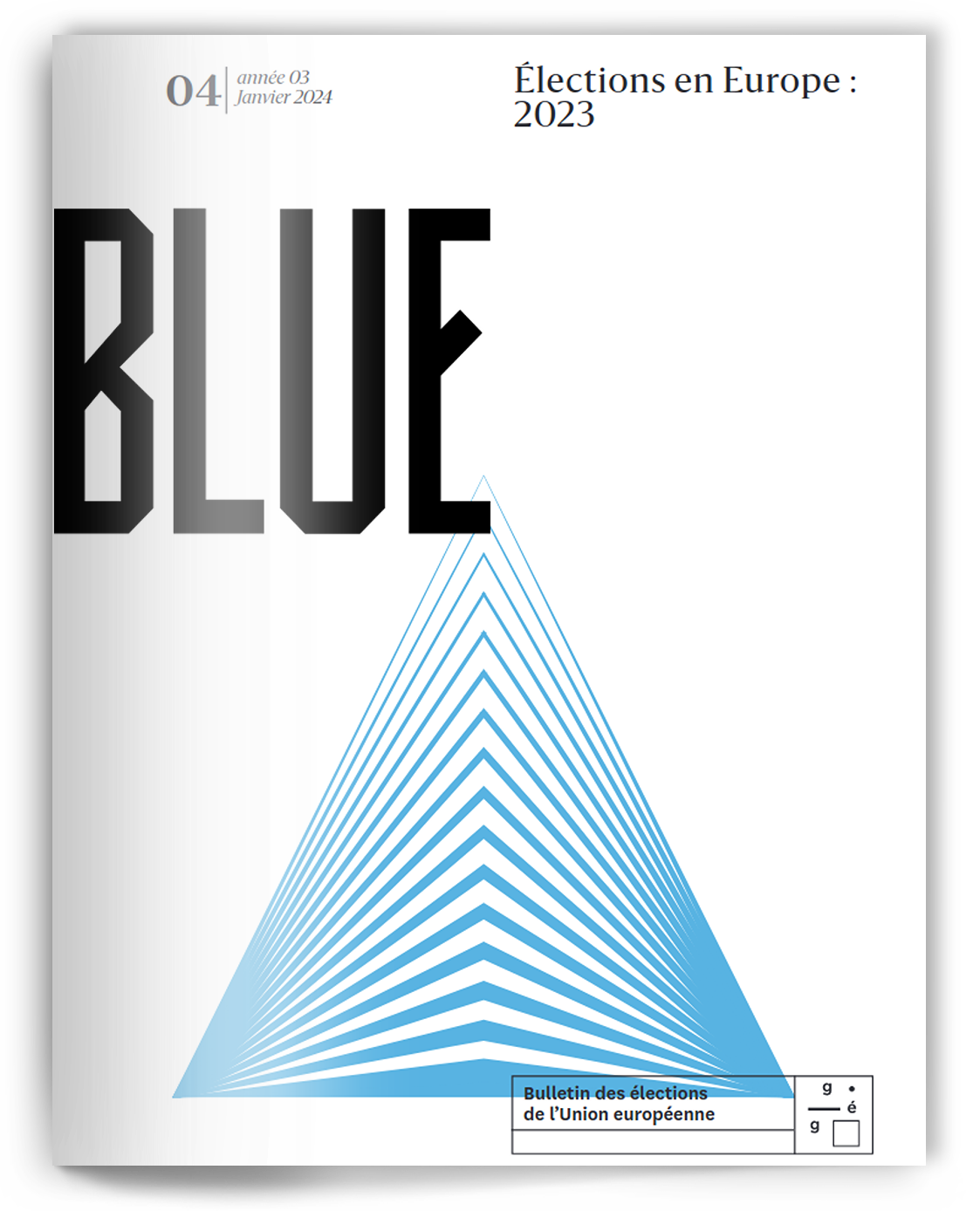
Issue 4, January 2024
Elections in Europe: 2023
Context
The Parliament of the Åland Islands, a territory with a population of 30,000 inhabitants, of whom 90% are Swedish speakers, was created in 1922 with the recognition of Åland’s autonomy status within the new Finnish state. The Finnish Civil War (January-May 1918), which saw the Finnish Communists fight the Finnish Whites, was marked by Sweden’s unsuccessful attempt to seize the archipelago. Finland took the territorial dispute to the League of Nations in 1921. The League of Nations concluded that Åland belonged to Finland but called on the Finnish state to grant the Ålanders a status that would allow them to retain their language and customs. Ålandic citizenship is recognised in Finnish law: any person who was born or has lived for at least five years in the archipelago, is a Finnish citizen and can demonstrate good command of the Swedish language is considered an Ålandic citizen.
Outside the areas of foreign policy, customs, currency and justice, the regional Parliament, the Lagting, may legislate freely within the limits permitted by the Finnish Constitution and European law. Åland’s autonomy status is guaranteed under Article 120 of the Finnish Constitution and organised by an Act on the Autonomy of Åland, last revised in 1990. Since the 2010s, the regional government and the Finnish government have been discussing the need to reform Åland’s autonomy status, but the discussions have not yet been concluded. The archipelago also has a reserved seat in the Finnish Parliament.
The citizens of Åland were called to the polls on 15 October 2023 to elect the Lagting’s 30 members. The incumbent government coalition, composed of Prime Minister Veronica Thörnroos’ Åland Centre (Åländsk Centern, C, ALDE), the Coalition of Independents (Obunden Samling, ObS, right-wing regionalists), the Moderate Coalition for Åland (Moderat Samling för Åland, MSÅ) and Sustainable Initiative (Hållbart initiativ, Hi, PVE), faced several opposition parties: the Åland Liberals (Liberalerna på Åland, Lib), the Social Democrats (Socialdemokrater, S, centre-left) and the liberal and pro-independence Future of Åland party (Ålands Framtid, ÅF, EFA). A total of 205 candidates from 7 parties took part in the election. The Lagting’s 30 seats are filled for a four-year term under an open-list proportional representation system with no electoral threshold. Additionally, voters can express a preferential vote for one of the candidates of the list they select. The candidates on each list are then elected on the basis of the preferential votes they have received.
Campaign
The campaign focused mainly on regional issues. One of the most controversial issue in the campaign was the plan to install large offshore wind farms off the coast of the archipelago (Smeds 2023). The Coalition of Independents was the only party to oppose this measure head-on, while most of the centre-left supported it and the centre-right, while also in favour, insisted that the current plan was not yet final. To justify their opposition, the conservatives cited environmental protection, while the social democrats and ecologists argued for the need to support ecological transition and the development of energy independence, particularly with regard to Russian gas (Blix 2023). Several recurring topics in Ålandic politics were also debated: the future of territorial autonomy, municipal reform – a reduction from sixteen to four municipalities had been contemplated during the previous legislature but was later abandoned due to strong resistance and a change in majority – the archipelago’s specific customs regime, maritime traffic and the situation of public and health services. While there is widespread consensus in the archipelago that the public healthcare system must be preserved and all parties in the region promote a full-fledged welfare state, Åland is facing the twofold challenge of rising health costs and a shortage of qualified staff. This challenge has led some to question the size of the regional health system, whose viability will be a major issue for the new government. In foreign and defence policy, there is also consensus: the parties of the archipelage, whose autonomy status established in a period of Swedish-Finnish tensions includes demilitarisation, have no intention of calling this particularity into question for the time being (Kajander 2024). Still, the opposition has criticised what they perceived as the Åland executive’s deteriorating relationship with the central government in Helsinki (Blix 2023).
Polls and final election results
In the run-up to the election, polls conducted by Gallup from June 2022 onwards predicted a Liberal lead over the Centre party. The Liberals’ vote share oscillated between 22% and 27% between June 2022 and February 2023, while the Centre obtained a weaker result with 16% to 20%. The opposition parties as a whole (Lib, S, ÅF, etc.) enjoyed a comfortable lead of 20-28 percentage points over the governing coalition (Figure a).
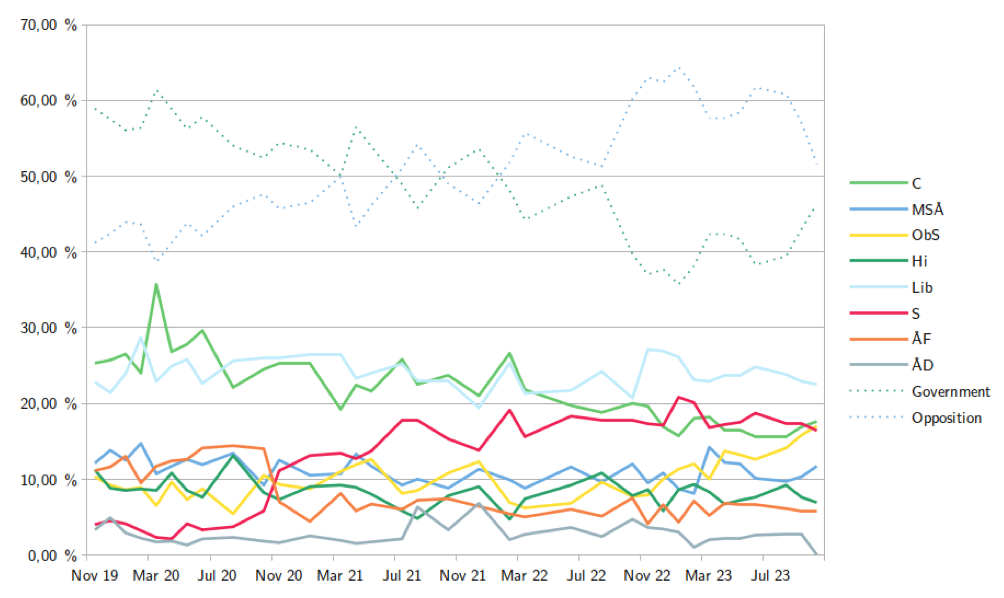
The Åland Democrats (DA, national-conservative), who held a seat in the Lagting and were credited with between 1% and 3% in the polls, announced that they would not be taking part in the election. Their chairman, Stephan Toivonen, justified the party’s decision with his own inability to stand in the election due to health reasons, as well as difficulties in identifying alternative candidates. The party has nevertheless signalled its intention to take part in the 2027 Åland elections. In the meantime, it has lost its representation on the Lagting.
Turnout was just under 68.29%, with 14,532 people voting on 15 October 2023, down 1.4 points from the last election in 2019.
Among the opposition parties, the Liberals became the largest party in Åland with 30% of the vote, 10 points more than in 2019, and saw their number of seats in the Lagting rise from six to nine. The Coalition of Independents (12.8%) also gained 3 points and took 5 seats, one more than in 2019. The Future of Åland fell to 2.8% from 4.7% in 2019 and did not obtain enough votes to retain its sole seat. In total, the opposition parties won 45.6% of the vote and 13 of the 30 seats.
Within the outgoing coalition, the leader of the coalition, the Centre (21.2%), lost 6 points compared to 2019, thereby losing two seats. The Centre now has just 7 seats but remains the archipelago’s second largest political party. Sustainable Initiative (5.1%) lost 3 points compared to 2019 and went from two to just one seat. The Moderates (12.5%) fell by 3.5 percentage points but managed to retain their four seats. Finally, the Social Democrats rose by 1.5 percentage points (15.3%) from 3 to 4 seats. In total, the outgoing coalition won 54.2% of the vote and 17 of the 30 seats.
However, this vote was not enough to allow the outgoing coalition led by Prime Minister Veronica Thörnroos (C) to govern for another term. Thörnroos received only 293 personal votes, coming third on her own list. In contrast, Katrin Sjögren, a former Prime Minister from 2014 to 2019 and the leader of the Liberals, received 678 votes, the highest number received by any individual candidate in this election. This enabled Katrin Sjögren to form a coalition government with the support of the Centre and the Social Democrats, which won a vote of confidence in the Lagting on 11 December 2023.
The data
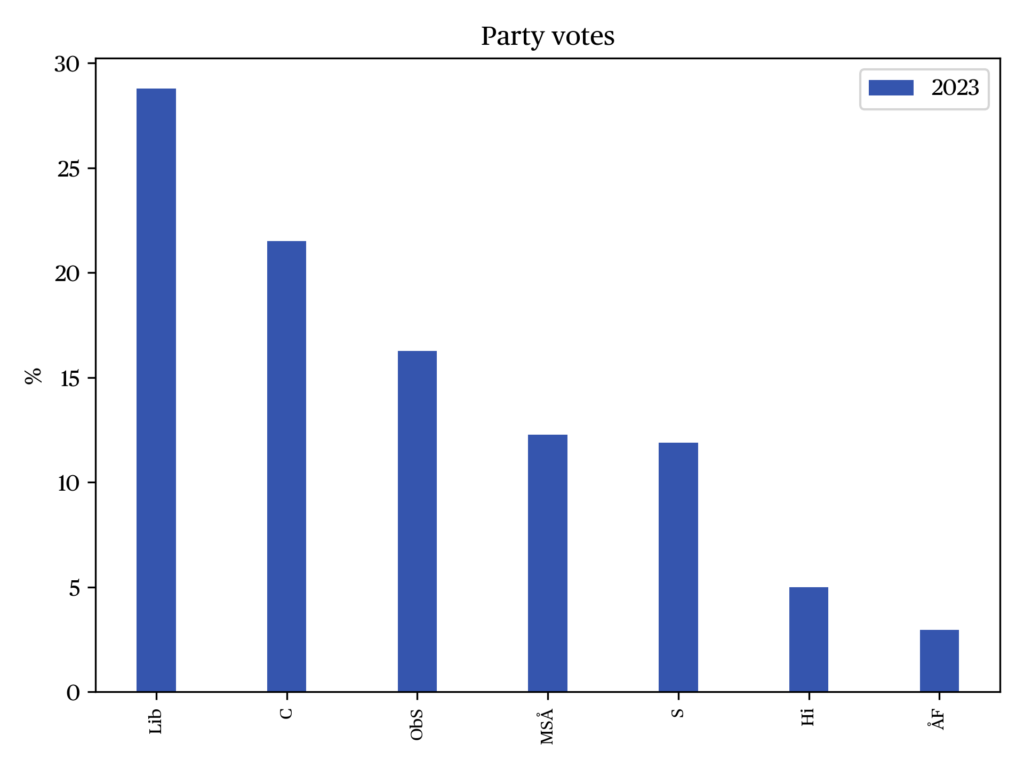
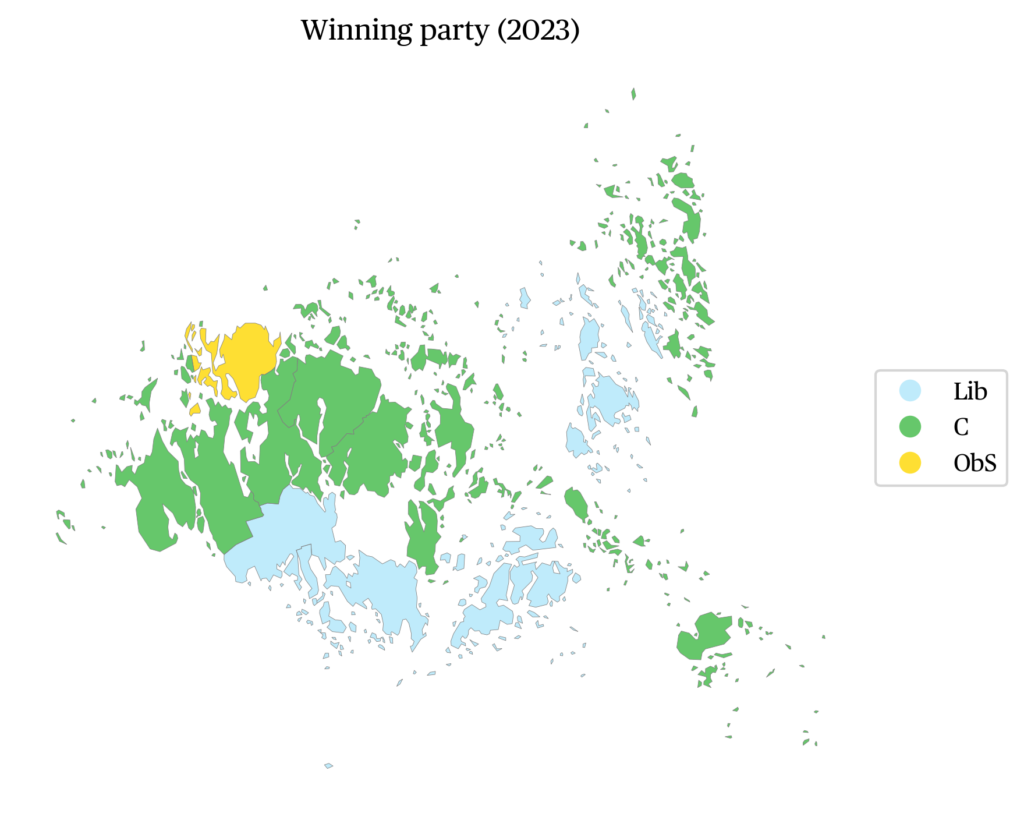
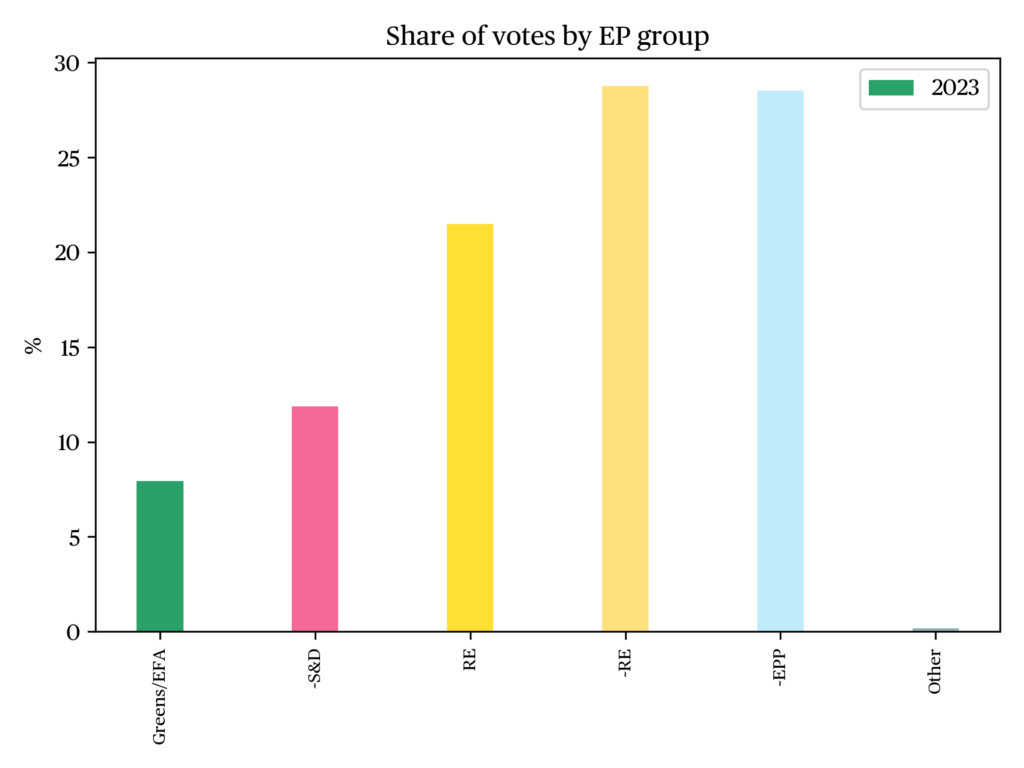
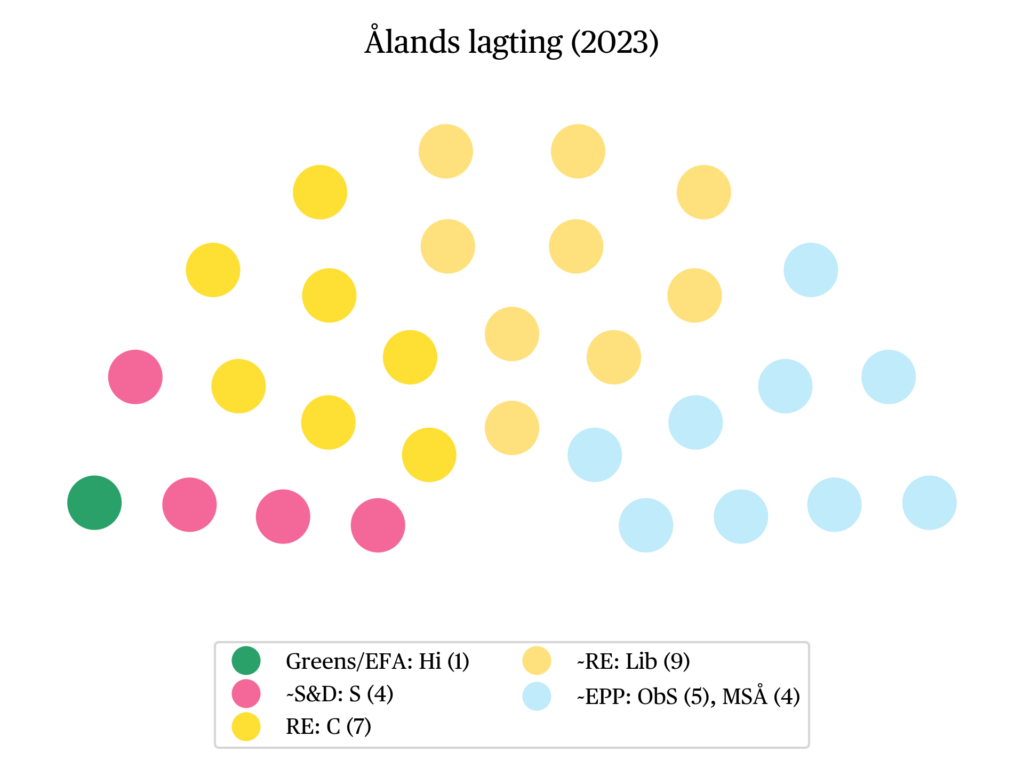
References
Blix, L. (2023, 12 October). Kommunerna, vindkraften och vården i fokus i Ålandstidningens debatt. Ålandstidningen. Online.
Kajander, S. (2023, 26 September). Taxfree på båtarna, färre kommuner och mer vindkraft – fem frågor då ålänningarna går till val. YLE. Online.
Smeds, N. (2023, 10 October). Klassiska frågor intresserar – men vindkraften stark uppstickare. Ålandstidningen. Online.
citer l'article
Jean-Toussaint Battestini, François Hublet, Regional election in Åland, 15 October 2023, Jun 2024,
à lire dans cette issue
voir toute la revue





